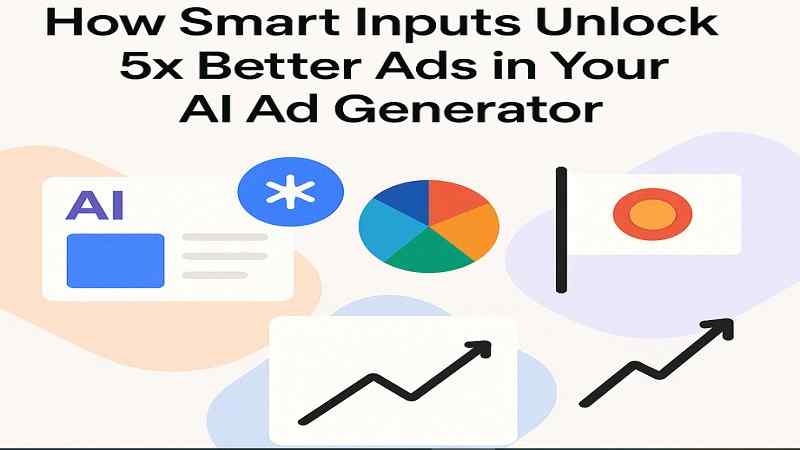AI ad generators have transformed how we scale campaigns, but here’s the catch: they’re only as good as what you feed them. With smart inputs, well-crafted prompts, clear branding, and personalized instructions, marketers are seeing up to 5 times better ad performance. Whether you’re using a free AI ad generator or a premium solution, your inputs determine your outcomes.
In this blog, we’ll unpack how to turn vague instructions into powerful inputs that help your AI ad generator create scroll-stopping, click-driving, conversion-boosting ads.
Actionable Tip: Start by auditing your current inputs. Are you giving your AI vague one-liners or detailed briefs? Use a spreadsheet to track input type, length, tone, and context for each ad.
The Power of Smart Inputs in AI Ad Generation
Smart inputs include detailed prompts, brand rules, audience personas, and performance goals that guide the AI. AI tools are only as strong as the data they receive. Better inputs lead to sharper, more context-aware outputs.
Example: Instead of “Create ad for shoes,” say, “Create an ad for waterproof men’s commuter shoes targeting urban millennials on Instagram Stories. Highlight breathability and style.”
This level of detail applies across AI ad generators whether you’re using a facebook AI ad generator, Google Ads AI ad generator, or an AI ad generator tool optimized for carousel and video formats.
Actionable Tip: Maintain a master document that outlines your campaign inputs. Include your brand tone, audience persona, and campaign CTA. Use it as a plug-and-play template.
Writing Better Prompts: The Foundation of High-Performing AI Ads
A smart prompt is specific, clear, contextual, and tone-defined.
Example Comparison:
- Weak: “Make an ad for coffee.”
- Strong: “Write a Facebook carousel ad for eco-conscious millennials who work from home. The product is single-origin coffee in compostable pods. Tone: witty, smart. Goal: conversions.”
These approaches make a difference even in one-click AI ad generator for SMBs, where limited input fields demand thoughtful detail.
Prompt Template Tip: Create templates per ad platform that include fields like Audience, Product Benefit, Platform, Format, and Tone.
Pro Tip: Don’t stop after one prompt. Generate, test, tweak, and refine iteratively.
Bonus Tip: Use Cognitive Biases to Strengthen Prompts
Incorporate persuasive psychological principles like:
- Loss Aversion: “Highlight what the customer stands to lose if they don’t act now.”
- Social Proof: “Mention that over 10,000 users already trust this product.”
- Anchoring: “Compare a $29 price point against a $99 market alternative.”
- Scarcity: “Emphasize limited stock or limited-time offers.”
- Authority Bias: “Reference endorsements by credible experts or institutions.”
Prompt Example Using Bias: “Create a Facebook ad for a fitness app targeting busy professionals aged 25–40. Highlight expert-designed routines and a limited-time discount. Mention how over 50,000 users rated it 4.9+ stars. Tone: Motivational and credible.”
Branding: Ensuring Consistency and Authenticity
Consistency in tone and visuals helps build trust. You can set up branding in AI tools by uploading voice descriptors, visual assets, and training data.
Whether you’re running ads via an AI image ad generator or an AI ad generator app, it’s essential to ensure that every output reflects your brand identity.
Actionable Tip: Upload brand boards and campaign archives to train the AI. Include examples of approved vs. rejected content.
Customization: Targeting, Localization, and Format Optimization
Smart inputs allow for hyper-specific targeting, like personalizing copy for new vs. returning customers, or localizing content for different regions.
Example: Use AI to auto-adapt a U.S.-based snow boot ad into a rain boot ad for Southeast Asia.
With features like AI vide ad generator , you can adapt tone and visuals for specific audience segments across formats and platforms.
Tip: Use modular prompt templates and dynamic creative tools to build once and deploy many variations.
Integrate your Customer Data Platform (CDP) with your AI ad generator tool to dynamically pull in user attributes for real-time customization.
Measuring Impact: How Smart Inputs Drive 5x Better Results
Tracking performance metrics like CTR (Click-Through Rate), CPA (Cost Per Acquisition), ROAS (Return on Ad Spend), and conversion rate is essential to understand the true effectiveness of your inputs. These metrics act as feedback loops—telling you not just how the ad performed, but why it performed that way.
- CTR reflects how compelling your ad’s hook is. A low CTR may indicate a weak headline or creative that failed to capture attention.
- CPA helps measure cost-efficiency. If it’s high, your input may not align with your audience’s needs or stage in the funnel.
- ROAS gives you the big picture of campaign profitability. A better input strategy that improves targeting and messaging often leads to a higher ROAS.
- Conversion Rate shows persuasive power. High CTR but low conversions? The prompt might be failing in clarity or call to action.
A fintech company improved CTR by 52% after shifting from generic prompts to persona-driven, goal-specific inputs. They tested prompts that focused on reducing hidden fees (loss aversion) and another highlighting that “over 50,000 customers switched this month” (social proof).
Actionable Tip: Create a log that tracks your prompt style like did you emphasize urgency, value, or social proof? Compare how each performed on different platforms. Even a free AI ad generator with basic analytics can help you understand which psychological angles (cognitive biases) are working. This builds a performance playbook over time that removes guesswork.
Conclusion
The difference between mediocre and high-performing AI ads? Your inputs. Smart, strategic prompts combined with clear branding and smart segmentation can significantly lift ad performance.
Whether you’re using an AI ad maker for Facebook, exploring the best AI ad generator for small businesses, or planning to buy AI ad generator software, remember: better inputs equal better results.
Final Tip: Think of prompts as your new media buy to test, optimize, and scale with intent.
[CTA: Try This Free Smart Prompt Builder Template]

